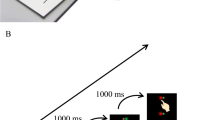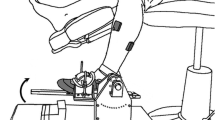Abstract
The purpose of this study was to determine whether the neuromuscular control of goal-directed movements is different for young and older adults with the upper and lower limbs. Twenty young (25.1 ± 3.9 years) and twenty older adults (71.5 ± 4.8 years) attempted to accurately match the displacement of their limb to a spatiotemporal target during ankle dorsiflexion or elbow flexion movements. We quantified neuromuscular control by examining the movement endpoint accuracy and variability, and the antagonistic muscle activity using surface electromyography (EMG). Our results indicate that older adults exhibit impaired endpoint accuracy with both limbs due to greater time variability. In addition, older adults exhibit greater EMG burst and lower EMG burst variability as well as lower coactivation of the antagonistic muscles. The impaired accuracy of older adults during upper limb movements was related to lower coactivation of the antagonistic muscles, whereas their impaired accuracy during lower limb movements was related to the amplified EMG bursts. The upper limb exhibited greater movement control than the lower limb, and different neuromuscular parameters were related to the accuracy and consistency for each limb. Greater endpoint error during upper limb movements was related to lower coactivation of the antagonistic muscles, whereas greater endpoint error during lower limb movements was related to the amplified EMG bursts. These findings indicate that the age-associated impairments in movement control are associated with altered activation of the involved antagonistic muscles. In addition, independent of age, the neuromuscular control of goal-directed movements is different for the upper and lower limbs.







Similar content being viewed by others
References
Bartzokis G, Beckson M, Lu PH, Nuechterlein KH, Edwards N, Mintz J (2001) Age-related changes in frontal and temporal lobe volumes in men: a magnetic resonance imaging study. Arch Gen Psychiatry 58:461–465. doi:10.1001/archpsyc.58.5.461
Basso D, Olivetti Belardinelli M (2006) The role of the feedforward paradigm in cognitive psychology. Cogn Process 7:73–88. doi:10.1007/s10339-006-0034-1
Brouwer B, Ashby P (1990) Corticospinal projections to upper and lower limb spinal motoneurons in man. Electroencephalogr Clin Neurophysiol 76:509–519
Brouwer B, Ashby P (1992) Corticospinal projections to lower limb motoneurons in man. Exp Brain Res 89:649–654
Chen YT, Pinto Neto O, de Miranda Marzullo AC, Kennedy DM, Fox EJ, Christou EA (2012) Age-associated impairment in endpoint accuracy of goal-directed contractions performed with two fingers is due to altered activation of the synergistic muscles. Exp Gerontol 47:519–526. doi:10.1016/j.exger.2012.04.007
Christou EA (2011) Aging and variability of voluntary contractions. Exerc Sport Sci Rev 39:77–84. doi:10.1097/JES.0b013e31820b85ab
Christou EA, Enoka RM (2011) Aging and movement errors when lifting and lowering light loads. Age (Dordr) 33:393–407. doi:10.1007/s11357-010-9190-4
Christou EA, Zelent M, Carlton LG (2003) Force control is greater in the upper compared with the lower extremity. J Mot Behav 35:322–324
Christou EA, Poston B, Enoka JA, Enoka RM (2007) Different neural adjustments improve endpoint accuracy with practice in young and old adults. J Neurophysiol 97:3340–3350
Desmurget M, Grafton S (2000) Forward modeling allows feedback control for fast reaching movements. Trends Cogn Sci 4:423–431
Elias LJ, Bryden MP, Bulman-Fleming MB (1998) Footedness is a better predictor than is handedness of emotional lateralization. Neuropsychologia 36:37–43
Elliott D, Helsen WF, Chua R (2001) A century later: Woodworth’s (1899) two-component model of goal-directed aiming. Psychol Bull 127:342–357
Elliott D, Hansen S, Grierson LE, Lyons J, Bennett SJ, Hayes SJ (2010) Goal-directed aiming: two components but multiple processes. Psychol Bull 136:1023–1044. doi:10.1037/a0020958
Enoka RM, Christou EA, Hunter SK, Kornatz KW, Semmler JG, Taylor AM, Tracy BL (2003) Mechanisms that contribute to differences in motor performance between young and old adults. J Electromyogr Kinesiol 13:1–12
Falconer K, Winter DA (1985) Quantitative assessment of co-contraction at the ankle joint in walking. Electromyogr Clin Neurophysiol 25:135–149
Goble DJ, Coxon JP, Wenderoth N, Van Impe A, Swinnen SP (2009) Proprioceptive sensibility in the elderly: degeneration, functional consequences and plastic-adaptive processes. Neurosci Biobehav Rev 33:271–278. doi:10.1016/j.neubiorev.2008.08.012
Gordon J, Ghez C (1987) Trajectory control in targeted force impulses. III. Compensatory adjustments for initial errors. Exp Brain Res 67:253–269
Gribble PL, Mullin LI, Cothros N, Mattar A (2003) Role of cocontraction in arm movement accuracy. J Neurophysiol 89:2396–2405
Hairi NN, Cumming RG, Naganathan V et al (2010) Loss of muscle strength, mass (sarcopenia), and quality (specific force) and its relationship with functional limitation and physical disability: the concord health and ageing in men project. J Am Geriatr Soc 58:2055–2062. doi:10.1111/j.1532-5415.2010.03145.x
Kornatz KW, Christou EA, Enoka RM (2005) Practice reduces motor unit discharge variability in a hand muscle and improves manual dexterity in old adults. J Appl Physiol 98:2072–2080
Kwon M, Baweja HS, Christou EA (2011) Age-associated differences in positional variability are greater with the lower limb. J Mot Behav 43:357–360. doi:10.1080/00222895.2011.598893
Kwon M, Chen Y-T, Reid JC, Fox EJ, Christou EA (2012) Impaired endpoint accuracy of goal-directed movements in older adults is related to greater time variability and altered antagonist muscle activity. In: Society for Neuroscience, New Orleans, LO, p 272.212/HH214
Laidlaw DH, Bilodeau M, Enoka RM (2000) Steadiness is reduced and motor unit discharge is more variable in old adults. Muscle Nerve 23:600–612
Mochizuki G, Semmler JG, Ivanova TD, Garland SJ (2006) Low-frequency common modulation of soleus motor unit discharge is enhanced during postural control in humans. Exp Brain Res 175:584–595. doi:10.1007/s00221-006-0575-7
Oldfield RC (1971) The assessment and analysis of handedness: the Edinburgh inventory. Neuropsychologia 9:97–113
Poston B, Enoka JA, Enoka RM (2008a) Endpoint accuracy for a small and a large hand muscle in young and old adults during rapid, goal-directed isometric contractions. Exp Brain Res 187:373–385. doi:10.1007/s00221-008-1309-9
Poston B, Enoka JA, Enoka RM (2008b) Practice and endpoint accuracy with the left and right hands of old adults: the right-hemisphere aging model. Muscle Nerve 37:376–386. doi:10.1002/mus.20954
Poston B, Christou EA, Enoka JA, Enoka RM (2010) Timing variability and not force variability predicts the endpoint accuracy of fast and slow isometric contractions. Exp Brain Res 202:189–202. doi:10.1007/s00221-009-2126-5
Prodoehl J, Vaillancourt DE (2010) Effects of visual gain on force control at the elbow and ankle. Exp Brain Res 200:67–79. doi:10.1007/s00221-009-1966-3
Rand MK, Wang L, Musseler J, Heuer H (2013) Vision and proprioception in action monitoring by young and older adults. Neurobiol Aging 34:1864–1872. doi:10.1016/j.neurobiolaging.2013.01.021
Sainburg RL (2002) Evidence for a dynamic-dominance hypothesis of handedness. Exp Brain Res 142:241–258
Sanguineti V, Morasso PG, Baratto L, Brichetto G, Luigi Mancardi G, Solaro C (2003) Cerebellar ataxia: quantitative assessment and cybernetic interpretation. Hum Mov Sci 22:189–205
Seidler RD, Alberts JL, Stelmach GE (2002) Changes in multi-joint performance with age. Mot Control 6:19–31
Seidler RD, Noll DC, Thiers G (2004) Feedforward and feedback processes in motor control. Neuroimage 22:1775–1783. doi:10.1016/j.neuroimage.2004.05.003
Seidler-Dobrin RD, He J, Stelmach GE (1998) Coactivation to reduce variability in the elderly. Mot Control 2:314–330
Shadmehr R, Smith MA, Krakauer JW (2010) Error correction, sensory prediction, and adaptation in motor control. Annu Rev Neurosci 33:89–108. doi:10.1146/annurev-neuro-060909-153135
Shaffer SW, Harrison AL (2007) Aging of the somatosensory system: a translational perspective. Phys Ther 87:193–207. doi:10.2522/ptj.20060083
Shinohara M (2011) Adaptations in motor unit behavior in elderly adults. Curr Aging Sci 4:200–208
Smeets JBJ (1994) Bi-articular muscles and the accuracy of motor control. Hum Mov Sci 13:587–600. doi:10.1016/0167-9457(94)90007-8
Tracy BL, Enoka RM (2002) Older adults are less steady during submaximal isometric contractions with the knee extensor muscles. J Appl Physiol 92:1004–1012
Tracy BL, Dinenno DV, Jorgensen B, Welsh SJ (2007) Aging, visuomotor correction, and force fluctuations in large muscles. Med Sci Sports Exerc 39:469–479. doi:10.1249/mss.0b013e31802d3ad3
Vaillancourt DE, Haibach PS, Newell KM (2006) Visual angle is the critical variable mediating gain-related effects in manual control. Exp Brain Res 173:742–750. doi:10.1007/s00221-006-0454-2
van Schaik CS, Hicks AL, McCartney N (1994) An evaluation of the length-tension relationship in elderly human ankle dorsiflexors. J Gerontol 49:B121–B127
Wolpert DM, Kawato M (1998) Multiple paired forward and inverse models for motor control. Neural Netw 11:1317–1329
Wolpert DM, Ghahramani Z, Jordan MI (1995) An internal model for sensorimotor integration. Science 269:1880–1882
Wolpert DM, Diedrichsen J, Flanagan JR (2011) Principles of sensorimotor learning. Nat Rev Neurosci 12:739–751. doi:10.1038/nrn3112
Yoon T, Keller ML, DeLap BS, Harkins A, Lepers R, Hunter SK (2009) Sex differences in response to cognitive stress during a fatiguing contraction. J Appl Physiol 107:1486–1496. doi:10.1152/japplphysiol.00238.2009
Acknowledgments
The authors would like to acknowledge the help of Jessica A Reid for data collection and the help of Jonathan D. Leake for computer programming. This study was supported by R01 AG031769 to Evangelos A. Christou.
Author information
Authors and Affiliations
Corresponding author
Rights and permissions
About this article
Cite this article
Kwon, M., Chen, YT., Fox, E.J. et al. Aging and limb alter the neuromuscular control of goal-directed movements. Exp Brain Res 232, 1759–1771 (2014). https://doi.org/10.1007/s00221-014-3868-2
Received:
Accepted:
Published:
Issue Date:
DOI: https://doi.org/10.1007/s00221-014-3868-2




